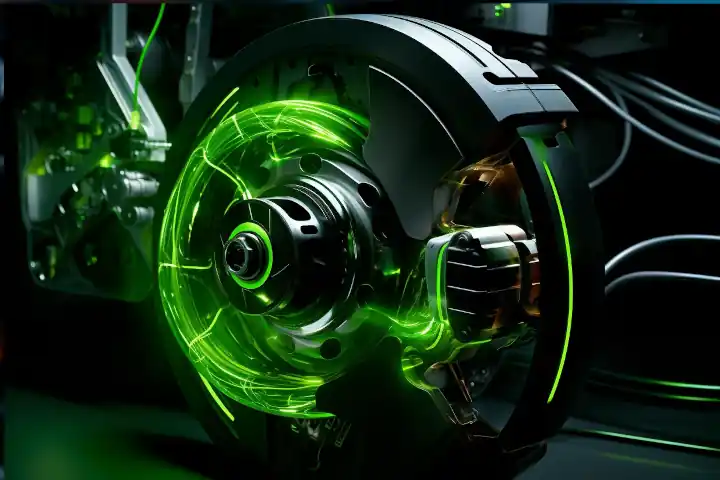eBike Regenerative Braking

Regenerative Brakes on eBikes
Spinning a coil of wire inside a magnet produces electricity. Power stations scale this simple model in their electric turbines, increasing the number of coils, the number of magnets, and the physical size of the system.
Electric motors are simply an electric turbine in reverse. When we push electricity into a coil inside a magnet it can move the coil (or magnets).
When we open the throttle on an eBike, we supply electricity into the motor to drive it forward. When we close the throttle the motor generates electricity. The electricity produces can be fed back into the battery to top up the charge. When you accelerate, the battery is supplying energy to the motor and the process is reversed when you brake.

Parallel RBS
These systems are activated along with the mechanical brakes as soon as the brakes are applied. The system recovers charge immediately, however, much energy is lost as mechanical brakes reduce the energy recapture. Parallel systems are also difficult to balance between regen and friction braking and can feel awkward under braking.
Serial RBS
Serial regenerative braking is more efficient than parallel system. Serial systems incorporate a more sophisticated controller which analyses brake lever position to calculate the amount of braking required. The controller tracks brake lever pressure and other perimeters of the EV. As the brake pedal is first pressed, only regenerative braking is engaged. As brake pressure is increased, friction braking is introduced to augment the regen braking. Balancing the combination of friction braking and regenerative braking is known as torque blending.
The controller distributes the amount of braking between the regenerative system and the friction brakes. This system is relatively complex as the controller has to calculate tire slip not only in a straight line but when the rider is cornering and control the variation in torque produced by the regenerative system at different speeds. Serial regeneration therefore requires the EV to have a VSE (Vehicle State Estimator). The VSE provides information about the speed, road traction, cornering and position of the vehicle (uphill/downhill).

How Much Power Can Regenerative Braking Produce?
Studies show that, in traffic, up to 50% of the energy used by a vehicle is lost in braking. Between 8% and 25% of the total battery energy used can be recuperated through regenerative braking systems. In practice there are several factors that affect the amount of power that can be recaptured:
1. The efficiency of regenerative system used (Serial or parallel system),
2. How aggressive the driving style (aggressive driving allows greater energy recapture),
3. Road conditions (energy recapture increases in heavy traffic).
4. Vehicle speed. Regenerative efficiency is higher if the braking is from a high speed and of relatively long duration.
The amount of power produced by regenerative braking cannot always be recovered. Controllers must include sensors to detect the level of battery charge and how hot the battery is. These controls can prevent energy being returned if it would be detrimental to the battery.
Regenerative Braking On eBikes
Regenerative braking is rare on eBikes for a number of reasons:
1. Cost. The first issue is that efficient automated RBS’s are costly. As most eBikes cost less than $5000, the relative cost of efficient, automated systems, is prohibitive.
2. Small charge return. The low speeds of and small mass of eBikes means that the recovery charge is relatively small.
3. Wheel lock up. During braking, weight is transferred to the front wheel. More expensive eBikes are rear wheel drive which means the tire is more likely to skid under braking. If the wheel locks, no recovery charge is generated.
4. Battery degradation. As eBikes will only brake for short periods, there is a short duration of charge returned. Short, frequent recharges are detrimental to battery health and curtail the life expectancy of the battery. Similarly, low cost systems are not equipped with battery sensors so it is likely that RBS would over heat and over charge the battery.
By far the biggest issue with regenerative braking on electric bicycles is that they place an unacceptable burden on the rider. When an RBS is fitted to an eBike, the system will try to recover power every time the throttle is closed. This means that if the battery runs flat or the rider wants to pedal, the rider has to put in increased effort to overcome the regen braking system. Pedaling then becomes prohibitive.

Regenerative Braking Systems Available for eBikes
It is a simple matter to a RBS to your eBike. You simply replace your ebike controller (or ESC Electronic Speed Controller) with a regenerative controller. Most of these systems provide a button that can be placed on the handlebars to start the RBS. Energy recovery only initiates when the rider presses the button.
This system uses the riders intelligence to decide when to use regen braking. Typically, the button would only be used to help slow the eBike on long, downhill slopes.
Summary
Although it regenerative braking can be easily, and cheaply, installed on eBikes, current systems are not ideal.
The added burden to pedaling, together with low mass, low speed and relatively low cost of electric bicycles is prohibitive to intelligent RBS. These factors leave eBike riders with manual systems being the only usable option.
Regen braking is currently used more as a selling point for eBike manufacturers rather than a practical option to extend battery life.
Reference: “Benchmarking of Regenerative Braking” B. J. Varocky

